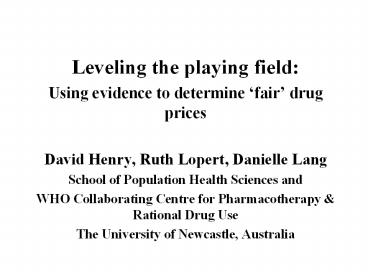Leveling the playing field:
Title:
Leveling the playing field:
Description:
Evidence-based pricing. The market for ... cost of $2000 is too high in country 2 ... Psaty et al. Health outcomes associated with anti-hypertensive ... –
Number of Views:26
Avg rating:3.0/5.0
Title: Leveling the playing field:
1
- Leveling the playing field
- Using evidence to determine fair drug prices
- David Henry, Ruth Lopert, Danielle Lang
- School of Population Health Sciences and
- WHO Collaborating Centre for Pharmacotherapy
Rational Drug Use - The University of Newcastle, Australia
2
What are drugs worth?
- How should drugs be valued?
- What should we be prepared to pay?
- Evidence-based pricing
3
The market for pharmaceuticals is flawed
- The industry has chosen to ignore large markets
- Lack of true competition
- Informational asymmetry
- Imbalance of market power - those who most need
are least able to afford drugs - Divergence of interests of customers and
investors - At prices offered new drugs often offer small
marginal gains for large marginal costs (seldom
seen in other technology and knowledge-based
industries)
4
Pharmacoeconomics
- Usually relates the net benefits to the net
costs, and the price is a given - cost-effectiveness ratios can be used to generate
indicative prices that represent value for
money in different communities/contexts - the application of economic utility theory and
consideration of social opportunity cost is
consistent with marked variation in prices in
different communities/contexts
5
Pharmacoeconomics
- The argument that a drug 'does not represent
value for money' is different from saying it is
'not affordable - The first is a confident statement from a
potential customer - The second an expression of helplessness
6
Pharmacoeconomics an example
- Drug X saves 1 life for every 10 treated
- Each survivor lives 10 years
- Drug X costs 2000 (in Australia)
- It costs 102000 to gain 10 life years, so the
cost/LYG is 2000 - Does Drug X offer value for money in Australia?
7
The same drug in another country
- Drug X saves 1 life for every 10 treated
- Each survivor lives 10 years
- For every 10 persons treated we gain 10 life
years (LYG) - Assume an acceptable cost-effectiveness ratio
in country 2 is 200/LYG - Then the indicative value for money price in
that country is 200
8
What does 'value for money' mean in country 2?
- The acceptable ratio in country 2 is 200/LYG v
2000/LYG in Australia - The opportunity cost of 2000 is too high in
country 2 - Committing 200/LYG in country 2 is a good
investment compared with other life-saving
interventions
9
A case study using ACE-inhibitors
- Basic assumptions underlying the analysis
- Set value of LYG as equivalent to a proportion
of per capita GNP (A proxy measure of value) not
a judgment of intrinsic worth
10
Estimates of benefit of ACE-Is
- Derived from systematic (Cochrane) reviews
- In treatment of hypertension
- - no evidence of benefit over diuretics /
?-blockers - In congestive heart failure
- - clear benefit over placebo
- In patients with left ventricular dysfunction
after heart attack - - clear benefit over placebo
11
Magnitude of the benefit
12
Other assumptions in the model
- Use of ACE-s is 90 for hypertension, 8 for CHF,
2 for post-MI (base case) - Treatment of hypertension requires one DDD, of
CHF 2DDDs, post-MI 3DDDs
13
Method
- From
- estimates of LYGs derived from the meta-analyses,
combined with . . . - value of LYG, set to a proportion of per capita
GNP . . . - calculate an implied incremental
cost-effectiveness ratio, and from this . . . - an indicative price (the price which would have
resulted in this ICER)
14
Results
Base case 90 hypertension, 8 CCF, 2 post-MI
15
Results (2) 80 HT, 15 CHF, 5 post MI
16
Limitations of the methodology
- Per capita GNP as proxy measure of affordability
is arbitrary (and probably not linear) - Method dependent on the quality/applicability of
evidence - Any effect modifiers should be included
- The present example takes no account of cost
offsets - Must be supported by underlying data collection
systems to inform the context
17
Advantages of the methodology
- Places PE in context
- Establishes nexus between price, value and
evidence of benefit - Price not derived from cost of RD or production
- Can be used in price/volume agreements
- EBM foundation is empowering
18
Sources of evidence
- Blood Pressure Lowering Triallists'
Collaboration. Effect of ACE inhibitors, calcium
antagonists, and other blood-pressure-lowering
drugs results of prospectively designed
overviews of randomised trials. Lancet
(2000)3561955-1964 - Psaty et al. Health outcomes associated with
anti-hypertensive therapies used as first-line
agents. JAMA (1997)277739-745. - The SOLVD Investigators. Effect of enalapril on
survival in patients with reduced left
ventricular ejection fractionsand congestive
heart failure. NEJM (1991)325293-302. - Pfeffer et al. Effect of captopril on mortality
and morbidity in patients with left ventricular
dysfunction after myocardial infarction. NEJM
(1992)327669-677.































